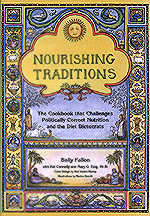Part one of a three part article (part2)
In order to believe that our society has "progressed,"
we must believe first that the lives of our ancestors were
indeed nasty, brutish and short. But, as study after study
has confirmed, the health of traditional peoples was vastly
superior to that of modern industrial man.
Modern technology—father of the combine harvester,
the automobile, the flush toilet and the fully electric
house—does not bestow his blessings without a price.
These twentieth century tools that have conferred freedom
of movement and comfort, and freedom from drudgery and dirt,
leave dark trailings of pollution, congestion and alienation.
This much is apparent. The wise use of technology has exercised
the minds of thinkers and writers for a fair number of decades.
Less obvious is the connection between modern technology
and health. Conventional wisdom asserts that our current
health crisis—in which one in three people in the
Western world develops cancer and almost half suffer from
heart disease—will be solved by more technology, not
less, and that disease, like drudgery and dirt, will give
way to a combination of innovation and funding.
My colleague, Dr. Tom Cowan, likes to tell the story of
a typical patient who comes in for a checkup. "It's
just a precaution," says the patient, "I'm actually
very healthy." Yes, he had his tonsils removed when
he was a youngster; he had his wisdom teeth taken out and
his teeth straightened with braces; he has a mouth full
of fillings and several root canals; he had a hernia operation
a few years ago and his back bothers him sometimes. True,
he often feels under stress, even depressed, and wishes
he had more energy, but he passes these off as normal conditions,
just what one would expect in the course of an average life-span.
 A
family history reveals a sister who died at the age of 40
from breast cancer and a father who is senile with Alzheimers
living in a nursing home. Both his children were born by
Cesarean section. They needed extensive (and expensive)
orthodontics. His daughter suffers from allergies and his
son attends a special school for the hyperactive and learning
disabled.
A
family history reveals a sister who died at the age of 40
from breast cancer and a father who is senile with Alzheimers
living in a nursing home. Both his children were born by
Cesarean section. They needed extensive (and expensive)
orthodontics. His daughter suffers from allergies and his
son attends a special school for the hyperactive and learning
disabled.
What allows Dr. Cowan's typical patient to claim that he
is healthy is, indeed, the same technology that gave us
the vacuum cleaner and the computer. Without the modern
inventions used to shore up his teeth, safely remove his
tonsils, repair his hernia and help his wife give birth,
our typical patient would be a toothless, childless cripple—or
dead before adulthood.
But the technology that allows him to fly to California
in five hours and illumine his living room with the flick
of a switch was not able to save his sister from cancer
nor his father from Alzheimers. The solutions proffered
for his depression and fatigue, his daughter's allergies
and his son's difficulties in school are palliative at best,
and dangerous at worst.
Modern technology allows the appearance of health but not
the substance. The age of solutions has a health crisis
it cannot solve. Although heart disease and cancer were
rare at the turn of the century, today these two diseases
strike with increasing frequency, in spite of billions of
dollars in research to combat them, and in spite of tremendous
advances in diagnostic and surgical techniques. In America,
one person in three suffers from allergies, one in ten will
have ulcers and one in five is mentally ill.
Every year, one quarter of a million infants are born with
a birth defect, who then undergo expensive heroic surgery,
or are hidden away in institutions. Other degenerative diseases—arthritis,
multiple sclerosis, digestive disorders, diabetes, osteoporosis,
Alzheimers's, epilepsy and chronic fatigue—afflict
a significant majority of our citizens. Learning disabilities
such as dyslexia and hyperactivity make life miserable for
seven million young people—not to mention their parents.
These diseases were extremely rare only a generation or
two ago. Today, chronic illness afflicts nearly half of
all Americans and causes three out of four deaths in the
United States. Most tragically, these diseases, formerly
the purview of the very old, now strike our children and
those in the prime of life. We have almost forgotten that
our natural state is one of balance, wholeness and vitality.
It seems as if the twentieth century will exit with a crescendo
of disease. Things were not so bad back in the 1930's, but
the situation was already serious enough to cause one Cleveland,
Ohio dentist to be concerned. Dr. Weston Price was reluctant
to accept the conditions exhibited by his patients as normal.
Rarely did an examination of an adult patient reveal anything
but rampant decay, often accompanied by serious problems
elsewhere in the body, such as arthritis, osteoporosis,
diabetes, intestinal complaints and chronic fatigue. (They
called it neurasthenia in Price's day.)
But it was the dentition of younger patients that alarmed
him most. Price observed that crowded, crooked teeth were
becoming more and more common, along with what he called
"facial deformities"—overbites, narrowed
faces, underdevelopment of the nose, lack of well-defined
cheekbones and pinched nostrils. Such children invariably
suffered from one or more complaints that sound all too
familiar to mothers of the 1990's: frequent infections,
allergies, anemia, asthma, poor vision, lack of coordination,
fatigue and behavioral problems. Price did not believe that
such "physical degeneration" was God's plan for
mankind. He was rather inclined to believe that the Creator
intended physical perfection for all human beings, and that
children should grow up free of ailments.
 He
had heard utopian stories about the good health of primitive
cultures and resolved to find out if the "backward"
societies that American was intent on evangelizing and colonizing
were indeed healthier than his own. For the next ten years,
he traveled to various isolated parts of the earth, where
the inhabitants had no contact with "civilization,"
in order to study their health and physical development.
He
had heard utopian stories about the good health of primitive
cultures and resolved to find out if the "backward"
societies that American was intent on evangelizing and colonizing
were indeed healthier than his own. For the next ten years,
he traveled to various isolated parts of the earth, where
the inhabitants had no contact with "civilization,"
in order to study their health and physical development.
His investigations took him to isolated Swiss villages
and a windswept island off the coast of Scotland. He studied
traditional Eskimos, Indian tribes in Canada and the Florida
Everglades, Southsea islanders, Aborigines in Australia,
Maoris in New Zealand, Peruvian and Amazonian Indians and
tribesmen in Africa.
Once Price had gained the confidence of the tribal or village
elders, he did what came naturally to him—he counted
cavities. Imagine his surprise at finding groups of people
in whom less than 1% of the permanent teeth were decayed.
He found 14 isolated groups in all where tooth decay was
rare to nonexistent, in people who had never seen a dentist
and never brushed their teeth. Freedom from caries always
went hand in hand with freedom from disease, both chronic
disease like cancer and heart disease, and infectious disease
like tuberculosis, which in Price's day afflicted much of
the world in epidemic proportions.
These studies occurred at a time when there still existed
remote pockets of humanity untouched by modern inventions;
but when one modern invention, the camera, allowed Price
to make a permanent record of the people he studied. The
photographs Price took, the descriptions of what he found
and his startling conclusions are preserved in a book considered
a masterpiece by many nutrition researchers who followed
in Price's footsteps: Nutrition and Physical Degeneration.1
Yet this compendium of ancestral wisdom is all but unknown
to today's parents and the medical community.
Nutrition and Physical Degeneration is the kind of book
that changes the way people view the world, because it describes
not only societies in which excellent health was the norm,
but also because it shows us how healthy people look. Healthy
people have faces that are broad, well-formed and noble.
Their teeth fill the smile with a band of dazzling whiteness,
as even and perfect as. . . false teeth.
Price took photograph after photograph of beautiful smiles,
and noted that "healthy primitives" were invariably
cheerful and optimistic. Such people were characterized
by "splendid physical development." The women
gave birth with ease. Their babies rarely cried and their
children were energetic and hearty. Many others have reported
a virtual absence of degenerative disease, particularly
cancer, in isolated, so-called "primitive" groups.2
Price observed a number of societies in transition where
stores or outposts had been established and native foods
were replaced by the products of western civilization—sugar,
white flour, condensed milk, canned foods, chocolate, jams
and pastries—what Price called the "displacing
foods of modern commerce." His photographs capture
the suffering caused by these foodstuffs—chiefly rampant
tooth decay. Even more startling, they show the change in
facial development that occurred with modernization.
Parents who had changed their diets gave birth to children
who no longer exhibited the tribal patterns. Their faces
were more narrow, their teeth crowded, their nostrils pinched.
These faces do not beam with optimism, like those of their
healthy ancestors. The photographs of Dr. Weston Price demonstrate
with great clarity that the "displacing foods of modern
commerce" do not provide sufficient nutrients to allow
the body to reach its full genetic potential—neither
the complete development of the bones in the body and the
head, nor the fullest expression of the various systems
that allow humankind to function at optimal levels—immune
system, nervous system, digestion and reproduction.
 The
diets of the healthy "primitives" Price studied
were all very different: In the Swiss village where Price
began his investigations, the inhabitants lived on rich
dairy products—unpasteurized milk, butter, cream and
cheese—dense rye bread, meat occasionally, bone broth
soups and the few vegetables they could cultivate during
the short summer months. The children's teeth were covered
in green slime but Price found only about one percent decay.
The
diets of the healthy "primitives" Price studied
were all very different: In the Swiss village where Price
began his investigations, the inhabitants lived on rich
dairy products—unpasteurized milk, butter, cream and
cheese—dense rye bread, meat occasionally, bone broth
soups and the few vegetables they could cultivate during
the short summer months. The children's teeth were covered
in green slime but Price found only about one percent decay.
The children went barefoot in frigid streams during weather
that forced Dr. Price and his wife to wear heavy wool coats;
nevertheless childhood illnesses were virtually nonexistent
and there had never been a single case of TB in the village.
Hearty Gallic fishermen living off the coast of Scotland
consumed no dairy products. Fish formed the mainstay of
the diet, along with oats made into porridge and oatcakes.
Fishheads stuffed with oats and chopped fish liver was a
traditional dish, and one considered very important for
growing children. The Eskimo diet, composed largely of fish,
fish roe and marine animals, including seal oil and blubber,
allowed Eskimo mothers to produce one sturdy baby after
another without suffering any health problems or tooth decay.
Well-muscled hunter-gatherers in Canada, the Everglades,
the Amazon, Australia and Africa consumed game animals,
particularly the parts that civilized folk tend to avoid—organ
meats, blood, marrow and glands, particularly the adrenal
glands—and a variety of grains, tubers, vegetables
and fruits that were available. African cattle-keeping tribes
like the Masai consumed no plant foods at all—just
meat, blood and milk.
Southsea islanders and the Maori of New Zealand ate seafood
of every sort—fish, shark, octopus, shellfish, sea
worms—along with pork meat and fat, and a variety
of plant foods including coconut, manioc and fruit. Whenever
these isolated peoples could obtain sea foods they did so—even
Indian tribes living high in the Andes.
Insects were another common food, in all regions except
the Arctic. The foods that allow people of every race and
every climate to be healthy are whole natural foods—meat
with its fat, organ meats, whole milk products, fish, insects,
whole grains, tubers, vegetables and fruit—not newfangled
concoctions made with white sugar, refined flour and rancid
and chemically altered vegetable oils.
Modern nutrition researchers are showing renewed interest
in the foodways of our ancestors, but myths about primitive
diets abound. The first is easily dismissed—that traditional
diets were largely vegetarian. Anthropological data confirm
what Price found, namely that throughout the globe, all
societies show a preference for animal foods and fats.3
Modern scientific literature does not support the claims
made for vegetarian diets.4
continued ...part2
Traditional Diets -- Nasty,Brutish, and Short?
by Sally Fallon
by Sally Fallon with Mary G Enig, PhD
The Cookbook that Challenges Politically Correct Nutrition
and the Diet Dictocrats.
This well-researched, thought-provoking guide to traditional
foods contains a startling message: Animal fats and cholesterol
are not villains but vital factors in the diet, necessary
for normal growth, proper funciton of the brain and nervous
system, protection from disease and optimum energy levels.
Sally Fallon dispels the myths of the current low-fat fad
in this practical, entertaining guide to a can-do diet that
is both nutritious and delicious.
Order
Sally Fallon's book at our
bookshop




 Nourishing
Traditions
Nourishing
Traditions
